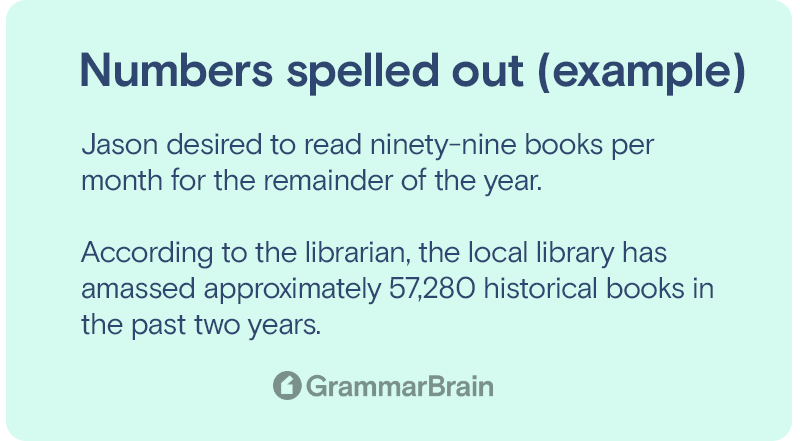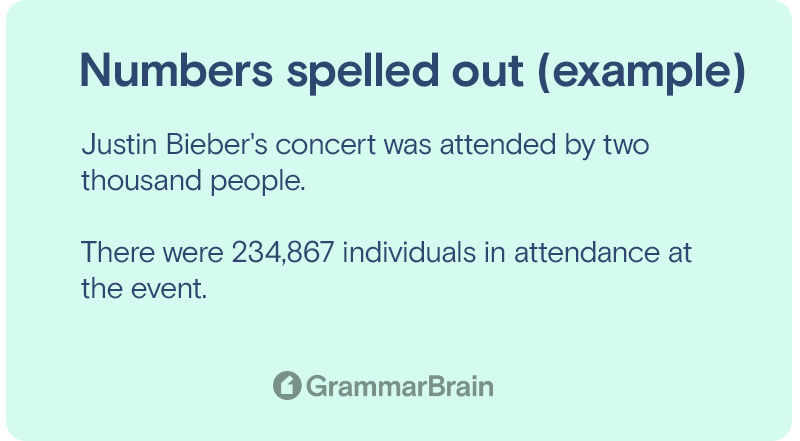Are numbers spelled out? Spelling out numbers versus utilizing figures (sometimes called numerals) is, with a few exceptions, mostly a matter of preference for writers. Once again, consistency is essential.
This is a difficult topic with numerous exceptions, and we cannot rely on any consistency among blogs, books, newspapers, and magazines.

When should numbers be written out in full?
In general, it is preferable to write out numbers from 0 to 100 in nontechnical writing. In scientific and technical writing, it is customary to write out numerals less than 10.
While there are exceptions to these guidelines, representing numbers consistently should be the priority.
Numbers can interfere with the reading of a paragraph, hence for most writing purposes, it is recommended to spell out numbers less than 101 as words.

Examples of numbers written out
- Jason desired to read ninety-nine books per month for the remainder of the year.
- According to the librarian, the local library has amassed approximately 57,280 historical books in the past two years.
When writing out numbers between forty and forty-nine, remember that the number forty does not contain a u.
There are exceptions to the criteria illustrated in the preceding instances, which are only general guidelines.
For example, round numerals such as hundreds, thousands, and millions should be typed out in their entirety. When writing numbers that are not round, it is preferable to use numerals.

Examples
- Justin Bieber’s concert was attended by two thousand people.
- There were 234,867 individuals in attendance at the event.
When a number starts a statement, it must always be spelled explicitly. Nevertheless, when numbers become cumbersome for the reader, authors frequently opt to reorganize their sentences.
Incorrect sentence
- Tomorrow, 8 people will attend the presentation.
Correct phrase
- Tomorrow, eight people will attend the presentation.
Writing large and small numbers
Small numbers from one to ten (or one to nine, depending on the style guide) should typically be written out in writing. Numbers greater than 10 are written as numerals.
This principle applies to scientific and technical writing.
Whole versus decimal numbers
Consider whether you are working with a full number or a decimal as a further factor. Always write decimals as numerals for clarity and accuracy.
Incorrect phrase
- This year, Jason’s grades improved by seven point five percent.
Correct phrase
- This year, Jason’s grades improved by 7.5%.

Paired numbers
Spell out one of the numbers when they appear adjacent to one another in a text. The goal of this guideline is to avoid reader confusion.
Incorrect phrase
- There were 10 5-year-olds waiting for their school bus at the bus station.
Correct phrase
- There were ten 5-year-olds waiting for their school bus at the bus station.
Or:
There were 10 five-year-olds waiting for their school bus at the bus station.
Seven rules for APA Number Formatting
The American Psychological Association (or APA) style guide focuses mostly on scientific writing, but it can also be applied to internet editorials.
The general guidelines for spelling out numbers are outlined below:
1. Spell out numbers less than ten
Ten and above should be written as numerals, while nine and below should be spelled out.
2. Spell out numbers at sentence beginnings
Even if the number is less than 10, a number that begins a sentence should be spelled out rather than written as a numeral.
3. Spell out fractions and common phrases with numbers
Spell out numbers in common phrases and fractions.
4. Use numerals for measuring purposes
If a number precedes a measurement (8 centimeters, 5 grams), use the numeral form.
5. For fractions, ratios, and percentages, use numerals
Any number used for data and statistics (82 percent, 3:1) should be written as a numeral, not a word.
6. Utilize numerals for monetary amounts, dates, ages, and times
When discussing monetary amounts, such as eight dollars, or a person’s age, four years, use numerals instead of spelling.
7. Series of numbers
When referencing a number in a series, such as Grade 2 or District 7, use the numeral and capitalize the preceding noun.
Five rules for correctly spelling numbers in Chicago Style
The Chicago Manual of Style provides specific guidelines for including numbers in the text.
1. Spell out the digits from zero to one hundred
Use numerals for numbers greater than 100, but spell out full numbers such as 300 and 1000.
2. Spell out cents for amounts under a dollar
For amounts less than one dollar, spell out the type of change rather than using a dollar sign or decimal point.
3. Spell out numerals when they appear at the beginning of a sentence
If a number begins a sentence, it should be written out in full rather than as a numeral.
4. Write out huge rounded figures in full
Large whole numbers greater than 100 that are followed by hundred, thousand, hundred thousand, or million should be written out unless they represent monetary sums.
5. Use numerals to represent fractions
Use numerals to represent common fractions unless they begin a phrase, in which case, spell them out using words.
Four rules for spelling numbers in MLA Format
Listed below are some guidelines for formatting numbers in accordance with the Modern Language Association (MLA) Style Guide.
1. Spell out numerals when they appear at the beginning of a sentence
If a numerical opens a sentence, it should be written out in full rather than as a numeral.
2. Spell out basic numerals
If a number can be expressed with one or two words (14, 99), it is spelled out. The use of numerals is required in all other circumstances.
3. Use hyphens between compound numerals
Use hyphens for the numbers between twenty-one and ninety-nine.
4. Utilize icons and abbreviations
When applicable, writers should pair numerals with their corresponding symbols, such as “$” or “%.”
FAQs
1. When should numbers be written out in full?
In general, words should be used for numbers between zero and nine, while numerals should be used for numbers ten and upwards.
2. Should a number put at the beginning of a phrase be spelled out or written as numerals?
Even if the number is greater than 10, a number that opens a sentence should be spelled out rather than written as a numeral.
3. How should mixed fractions get expressed?
They should be in figures unless they are starting a sentence.
4. What are the best tips for writing numbers?
Avoid mixing number words and numerals in lists. When writing out three or more digits, the word “and” isn’t necessary.
Sources
- The Rules for Writing Numbers in English
- When Should I Spell Out Numbers?
- Writing Numbers
- When to Spell Out Numbers According to Different Style Guides
Inside this article
Fact checked:
Content is rigorously reviewed by a team of qualified and experienced fact checkers. Fact checkers review articles for factual accuracy, relevance, and timeliness. Learn more.
Core lessons
Glossary
- Abstract Noun
- Accusative Case
- Anecdote
- Antonym
- Active Sentence
- Adverb
- Adjective
- Allegory
- Alliteration
- Adjective Clause
- Adjective Phrase
- Ampersand
- Anastrophe
- Adverbial Clause
- Appositive Phrase
- Clause
- Compound Adjective
- Complex Sentence
- Compound Words
- Compound Predicate
- Common Noun
- Comparative Adjective
- Comparative and Superlative
- Compound Noun
- Compound Subject
- Compound Sentence
- Copular Verb
- Collective Noun
- Colloquialism
- Conciseness
- Consonance
- Conditional
- Concrete Noun
- Conjunction
- Conjugation
- Conditional Sentence
- Comma Splice
- Correlative Conjunction
- Coordinating Conjunction
- Coordinate Adjective
- Cumulative Adjective
- Dative Case
- Determiner
- Declarative Sentence
- Declarative Statement
- Direct Object Pronoun
- Direct Object
- Diction
- Diphthong
- Dangling Modifier
- Demonstrative Pronoun
- Demonstrative Adjective
- Direct Characterization
- Definite Article
- Doublespeak
- False Dilemma Fallacy
- Future Perfect Progressive
- Future Simple
- Future Perfect Continuous
- Future Perfect
- First Conditional
- Irregular Adjective
- Irregular Verb
- Imperative Sentence
- Indefinite Article
- Intransitive Verb
- Introductory Phrase
- Indefinite Pronoun
- Indirect Characterization
- Interrogative Sentence
- Intensive Pronoun
- Inanimate Object
- Indefinite Tense
- Infinitive Phrase
- Interjection
- Intensifier
- Infinitive
- Indicative Mood
- Participle
- Parallelism
- Prepositional Phrase
- Past Simple Tense
- Past Continuous Tense
- Past Perfect Tense
- Past Progressive Tense
- Present Simple Tense
- Present Perfect Tense
- Personal Pronoun
- Personification
- Persuasive Writing
- Parallel Structure
- Phrasal Verb
- Predicate Adjective
- Predicate Nominative
- Phonetic Language
- Plural Noun
- Punctuation
- Punctuation Marks
- Preposition
- Preposition of Place
- Parts of Speech
- Possessive Adjective
- Possessive Determiner
- Possessive Case
- Possessive Noun
- Proper Adjective
- Proper Noun
- Present Participle
- Prefix
- Predicate



